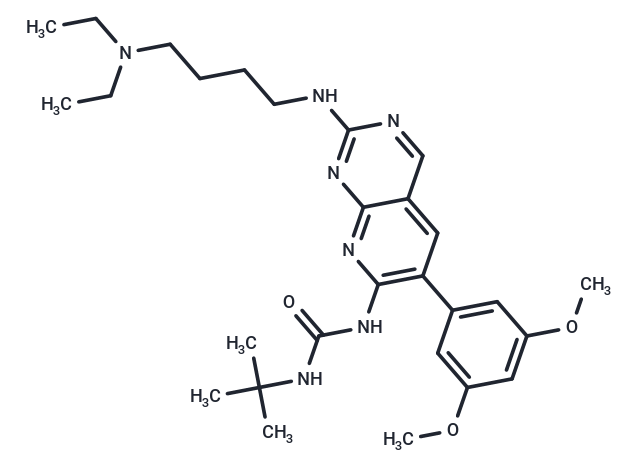Shopping Cart
- Remove All
 Your shopping cart is currently empty
Your shopping cart is currently empty

PD173074 is an effective FGFR1 inhibitor (IC50: 25 nM) and also inhibits VEGFR2 (IC50: 100-200 nM) in cell-free assays. The selectivity is higher ~1000-fold for FGFR1 than PDGFR and c-Src.

| Pack Size | Price | Availability | Quantity |
|---|---|---|---|
| 5 mg | $36 | In Stock | |
| 10 mg | $52 | In Stock | |
| 25 mg | $91 | In Stock | |
| 50 mg | $143 | In Stock | |
| 100 mg | $233 | In Stock | |
| 200 mg | $413 | In Stock | |
| 500 mg | $689 | In Stock | |
| 1 mL x 10 mM (in DMSO) | $54 | In Stock |
| Description | PD173074 is an effective FGFR1 inhibitor (IC50: 25 nM) and also inhibits VEGFR2 (IC50: 100-200 nM) in cell-free assays. The selectivity is higher ~1000-fold for FGFR1 than PDGFR and c-Src. |
| Targets&IC50 | VEGFR2:100 nM-200 nM, FGFR1:25 nM |
| In vitro | PD173074 dose-dependently inhibited the autophosphorylation of VEGFR2 (IC50: 100-200 nM) and FGFR1 (IC50: 1-5 nM). PD173074 dose-dependently inhibited FGF-2-promoted granule neuron survival (IC50: 12 nM), which was more than 1,000-fold higher than SU 5402 activity. PD173074 specifically inhibited FGF-2-mediated cell proliferation, differentiation and MAPK activation in oligodendrocyte lineage cells.PD173074 was an ATP-competitive inhibitor of FGFR1 (Ki: 40 nM).PD173074 also dose-dependently and potently inhibited the autophosphorylation of FGFR3 (IC50: 5 nM). In multiple myeloma cell lines, PD173074 was active against wild-type and FGFR3 mutant types.PD173074 caused a significant decrease in the viability of FGFR3-expressing KMS11 and KMS18 cells (IC50<20 nM). |
| In vivo | PD173074 dose-dependently inhibited the autophosphorylation of VEGFR2 (IC50: 100-200 nM) and FGFR1 (IC50: 1-5 nM). PD173074 dose-dependently inhibited FGF-2-promoted granule neuron survival (IC50: 12 nM), which was more than 1,000-fold higher than SU 5402 activity. PD173074 specifically inhibited FGF-2-mediated cell proliferation, differentiation and MAPK activation in oligodendrocyte lineage cells.PD173074 was an ATP-competitive inhibitor of FGFR1 (Ki: 40 nM).PD173074 also dose-dependently and potently inhibited the autophosphorylation of FGFR3 (IC50: 5 nM). In multiple myeloma cell lines, PD173074 was active against wild-type and FGFR3 mutant types.PD173074 caused a significant decrease in the viability of FGFR3-expressing KMS11 and KMS18 cells (IC50<20 nM). |
| Kinase Assay | In vitro kinase inhibition assays: Assays using the full-length FGFR-1 kinase are performed in a total volume of 100 μL containing 25 mM HEPES buffer (pH 7.4), 150 mM NaCl, 10 mM MnCl2, 0.2 mM sodium orthovanadate, 750 μg/mL concentration of a random copolymer of glutamic acid and tyrosine (4:1), various concentrations of PD173074 and 60 to 75 ng of enzyme. The reaction is initiated by the addition of [γ-32P]ATP (5 μM ATP containing 0.4 μCi of [γ-32P]ATP per incubation), and samples are incubated at 25°C for 10 minutes. The reaction is terminated by the addition of 30% trichloroacetic acid and the precipitation of material onto glass-fiber filter mats. Filters are washed three times with 15% trichloroacetic acid, and the incorporation of [32P] into the glutamate tyrosine polymer substrate is determined by counting the radioactivity retained on the filters in a Wallac 1250 betaplate reader. Nonspecific activity is defined as radioactivity retained on the filters following incubation of samples without enzyme. Specific activity is determined as total activity (enzyme plus buffer) minus nonspecific activity. The concentration of PD173074 that inhibits FGFR-1 enzymatic activity by 50% (IC50) is determined graphically. |
| Cell Research | Cells are incubated with increasing concentrations of PD173074 in the presence of aFGF/heparin for 48 hours. The percentage of viable cells is determined by MTT.(Only for Reference) |
| Molecular Weight | 523.67 |
| Formula | C28H41N7O3 |
| Cas No. | 219580-11-7 |
| Smiles | CCN(CC)CCCCNc1ncc2cc(c(NC(=O)NC(C)(C)C)nc2n1)-c1cc(OC)cc(OC)c1 |
| Relative Density. | 1.163 g/cm3 |
| Storage | Powder: -20°C for 3 years | In solvent: -80°C for 1 year | Shipping with blue ice. | |||||||||||||||||||||||||||||||||||
| Solubility Information | Ethanol: 52.4 mg/mL (100.06 mM), Sonication is recommended. DMSO: 60 mg/mL (114.58 mM), Sonication is recommended. | |||||||||||||||||||||||||||||||||||
Solution Preparation Table | ||||||||||||||||||||||||||||||||||||
Ethanol/DMSO
| ||||||||||||||||||||||||||||||||||||

Copyright © 2015-2025 TargetMol Chemicals Inc. All Rights Reserved.